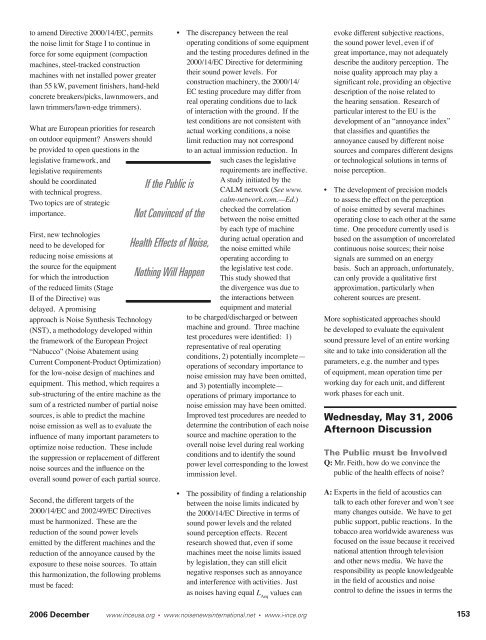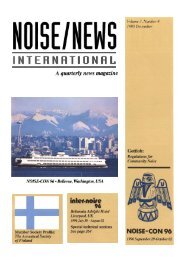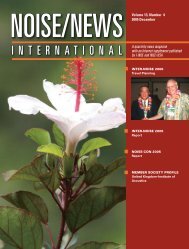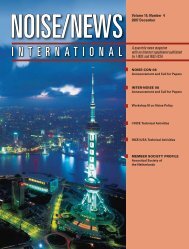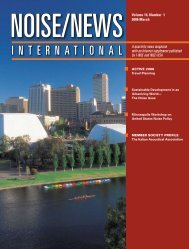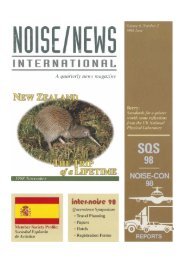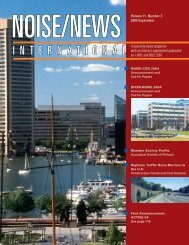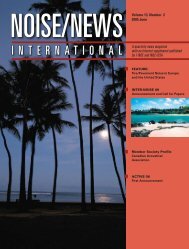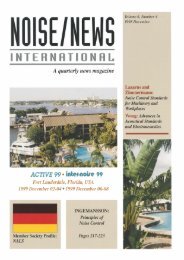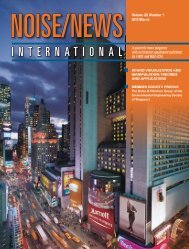Volume 14, Number 4, December, 2006 - Noise News International
Volume 14, Number 4, December, 2006 - Noise News International
Volume 14, Number 4, December, 2006 - Noise News International
Create successful ePaper yourself
Turn your PDF publications into a flip-book with our unique Google optimized e-Paper software.
to amend Directive 2000/<strong>14</strong>/EC, permits<br />
the noise limit for Stage I to continue in<br />
force for some equipment (compaction<br />
machines, steel-tracked construction<br />
machines with net installed power greater<br />
than 55 kW, pavement finishers, hand-held<br />
concrete breakers/picks, lawnmowers, and<br />
lawn trimmers/lawn-edge trimmers).<br />
What are European priorities for research<br />
on outdoor equipment? Answers should<br />
be provided to open questions in the<br />
legislative framework, and<br />
legislative requirements<br />
should be coordinated<br />
with technical progress.<br />
Two topics are of strategic<br />
importance.<br />
First, new technologies<br />
need to be developed for<br />
reducing noise emissions at<br />
the source for the equipment<br />
for which the introduction<br />
of the reduced limits (Stage<br />
II of the Directive) was<br />
delayed. A promising<br />
approach is <strong>Noise</strong> Synthesis Technology<br />
(NST), a methodology developed within<br />
the framework of the European Project<br />
“Nabucco” (<strong>Noise</strong> Abatement using<br />
Current Component-Product Optimization)<br />
for the low-noise design of machines and<br />
equipment. This method, which requires a<br />
sub-structuring of the entire machine as the<br />
sum of a restricted number of partial noise<br />
sources, is able to predict the machine<br />
noise emission as well as to evaluate the<br />
influence of many important parameters to<br />
optimize noise reduction. These include<br />
the suppression or replacement of different<br />
noise sources and the influence on the<br />
overall sound power of each partial source.<br />
Second, the different targets of the<br />
2000/<strong>14</strong>/EC and 2002/49/EC Directives<br />
must be harmonized. These are the<br />
reduction of the sound power levels<br />
emitted by the different machines and the<br />
reduction of the annoyance caused by the<br />
exposure to these noise sources. To attain<br />
this harmonization, the following problems<br />
must be faced:<br />
If the Public is<br />
Not Convinced of the<br />
Health Effects of <strong>Noise</strong>,<br />
Nothing Will Happen<br />
• The discrepancy between the real<br />
operating conditions of some equipment<br />
and the testing procedures defined in the<br />
2000/<strong>14</strong>/EC Directive for determining<br />
their sound power levels. For<br />
construction machinery, the 2000/<strong>14</strong>/<br />
EC testing procedure may differ from<br />
real operating conditions due to lack<br />
of interaction with the ground. If the<br />
test conditions are not consistent with<br />
actual working conditions, a noise<br />
limit reduction may not correspond<br />
to an actual immission reduction. In<br />
such cases the legislative<br />
requirements are ineffective.<br />
A study initiated by the<br />
CALM network (See www.<br />
calm-network.com.—Ed.)<br />
checked the correlation<br />
between the noise emitted<br />
by each type of machine<br />
during actual operation and<br />
the noise emitted while<br />
operating according to<br />
the legislative test code.<br />
This study showed that<br />
the divergence was due to<br />
the interactions between<br />
equipment and material<br />
to be charged/discharged or between<br />
machine and ground. Three machine<br />
test procedures were identified: 1)<br />
representative of real operating<br />
conditions, 2) potentially incomplete—<br />
operations of secondary importance to<br />
noise emission may have been omitted,<br />
and 3) potentially incomplete—<br />
operations of primary importance to<br />
noise emission may have been omitted.<br />
Improved test procedures are needed to<br />
determine the contribution of each noise<br />
source and machine operation to the<br />
overall noise level during real working<br />
conditions and to identify the sound<br />
power level corresponding to the lowest<br />
immission level.<br />
• The possibility of finding a relationship<br />
between the noise limits indicated by<br />
the 2000/<strong>14</strong>/EC Directive in terms of<br />
sound power levels and the related<br />
sound perception effects. Recent<br />
research showed that, even if some<br />
machines meet the noise limits issued<br />
by legislation, they can still elicit<br />
negative responses such as annoyance<br />
and interference with activities. Just<br />
as noises having equal L Aeq<br />
values can<br />
<strong>2006</strong> <strong>December</strong> www.inceusa.org • www.noisenewsinternational.net • www.i-ince.org<br />
evoke different subjective reactions,<br />
the sound power level, even if of<br />
great importance, may not adequately<br />
describe the auditory perception. The<br />
noise quality approach may play a<br />
significant role, providing an objective<br />
description of the noise related to<br />
the hearing sensation. Research of<br />
particular interest to the EU is the<br />
development of an “annoyance index”<br />
that classifies and quantifies the<br />
annoyance caused by different noise<br />
sources and compares different designs<br />
or technological solutions in terms of<br />
noise perception.<br />
• The development of precision models<br />
to assess the effect on the perception<br />
of noise emitted by several machines<br />
operating close to each other at the same<br />
time. One procedure currently used is<br />
based on the assumption of uncorrelated<br />
continuous noise sources; their noise<br />
signals are summed on an energy<br />
basis. Such an approach, unfortunately,<br />
can only provide a qualitative first<br />
approximation, particularly when<br />
coherent sources are present.<br />
More sophisticated approaches should<br />
be developed to evaluate the equivalent<br />
sound pressure level of an entire working<br />
site and to take into consideration all the<br />
parameters, e.g. the number and types<br />
of equipment, mean operation time per<br />
working day for each unit, and different<br />
work phases for each unit.<br />
Wednesday, May 31, <strong>2006</strong><br />
Afternoon Discussion<br />
The Public must be Involved<br />
Q: Mr. Feith, how do we convince the<br />
public of the health effects of noise?<br />
A: Experts in the field of acoustics can<br />
talk to each other forever and won’t see<br />
many changes outside. We have to get<br />
public support, public reactions. In the<br />
tobacco area worldwide awareness was<br />
focused on the issue because it received<br />
national attention through television<br />
and other news media. We have the<br />
responsibility as people knowledgeable<br />
in the field of acoustics and noise<br />
control to define the issues in terms the<br />
153


